Palm oil buyers switch to cheaper rival oils, hampering price recovery

The rebound in palm oil prices is likely to be capped by abundant supplies of rival soyoil and sunflower oil, “soft” oils that are available at discounts to tropical palm oil for the first time in more than a year.
Benchmark Malaysian palm oil futures have risen nearly 5 per cent in 2024 after losing 11 per cent last year.
Primary competitor soyoil typically trades at a premium to palm oil, but a record South American soybean crop has driven down prices, and buyers are taking more soyoil shipments.
Soft oils production is rising while palm oil production is falling, driving divergent price trends, said Vipin Gupta, chief executive officer of Dubai-based trader Glentech Group.
“Higher prices are pushing away buyers from palm oil, which will limit the price rise,” Gupta said.
Crude palm oil (CPO) imports are being offered at about US$930 a metric ton, including cost, insurance and freight (CIF), in India for March delivery, while soyoil and sunflower oil are offered around US$915 and US$910 a ton, respectively, dealers said.
Palm oil, available at a discount of nearly US$200 a ton to soyoil in November, is trading at premiums as dryness caused by El Nino weather is limiting output in the two largest producers, Indonesia and Malaysia.
In India, the top vegetable oil importer, buyers are trimming palm oil imports and increasing soyoil for shipments in coming months, said Sanjeev Asthana, CEO at Patanjali Foods, India’s top palm oil buyer.
Palm oil imports by India fell to their lowest in three months at 787,000 ton in January as soyoil purchases rose 24 per cent to 190,000 tons.
India’s soyoil imports could jump to 300,000 tons in March and further to 400,000 tons in April, while palm oil imports could fall to around 700,000 tons, said Sandeep Bajoria, CEO of Sunvin Group, a vegetable oil brokerage.
Negative refining margins for palm oil for Indian refiners contrast with the positive margin in soyoil and sunoil, prompting increases soft oil purchases, said Rajesh Patel, managing partner at edible oil trader and broker GGN Research.
India buys palm oil mainly from Indonesia, Malaysia and Thailand, while it imports soyoil and sunflower oil from Argentina, Brazil, Russia and Ukraine.
Due to higher freight costs, palm oil is even more expensive for European buyers and is trading in Europe at a premium of up to US$100 a ton over soyoil, canola oil and sunflower oil, said a Singapore-based dealer with a global trading house.
While high prices are likely to squeeze household consumption, industrial demand for palm oil is likely to remain intact, the Singapore dealer said.
In Pakistan, palm oil is primarily used to make vanaspati ghee, a cheaper substitute for clarified butter, for which demand will persist, said Rasheed JanMohd, chief executive of Karachi-based Westbury Group.
Palm oil is expected to maintain its premium for at least a few months, as production in Indonesia and Malaysia declines and demand for biodiesel in Indonesia rises, said a Kuala Lumpur-based vegetable oil trader.
“Palm oil stocks are decreasing in producing countries, which will give them leverage to quote higher prices,” the trader said.
Malaysia’s palm oil stocks likely fell for the third straight month in January, a Reuters survey showed.
Read also
Wheat in Southern Brazil Impacted by Dry Weather and Frosts
Oilseed Industry. Leaders and Strategies in the Times of a Great Change
Black Sea & Danube Region: Oilseed and Vegoil Markets Within Ongoing Transfor...
Serbia. The drought will cause extremely high losses for farmers this year
2023/24 Safrinha Corn in Brazil 91% Harvested
Write to us
Our manager will contact you soon



